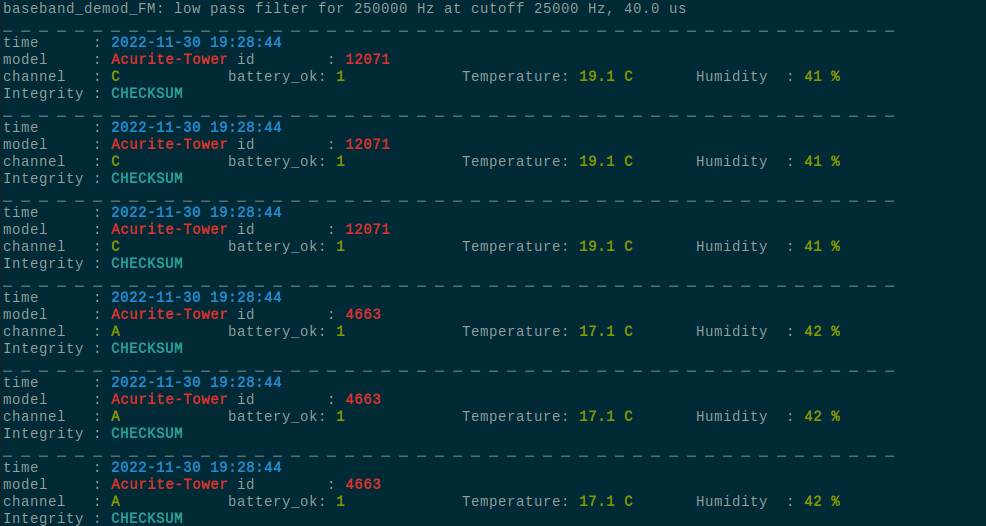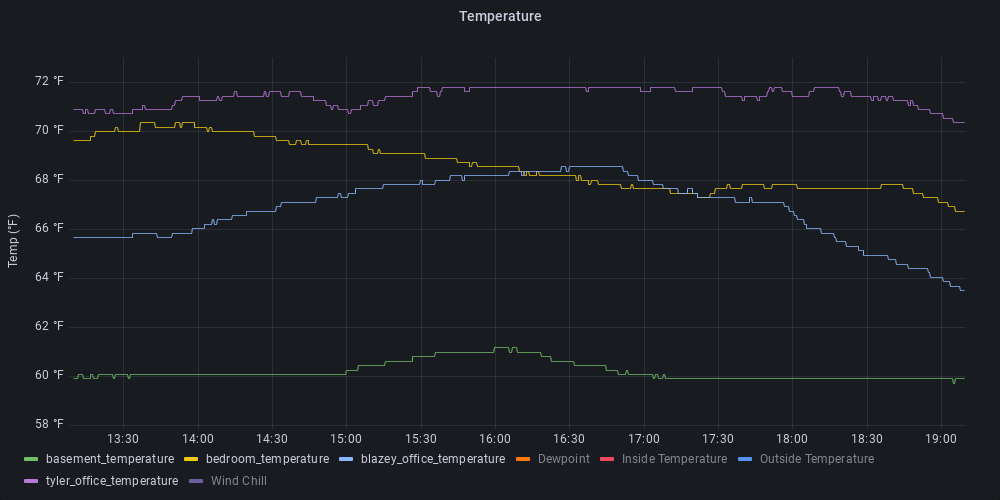One accurate measurement is worth a thousand expert opinions – Grace Hopper As I meandered around our new house, it was apparent some rooms were
sweltering, others were freezing, and the thermostat was lying about
everything. I could feel it. But I felt compelled to measure it. I was struck by
the need to know: And I fulfilled my weird compulsion with a few simple tools: I have a handful of AcuRite
sensors sprinkled throughout my house. These sensors are $16 today, but I bought mine around 2017 for $12
each at Home Depot. I know I could cobble together a cheaper temperature sensor: So for like $10 + solder + a weekend fiddling, you could make a
craptastic internet-equipped temperature/humidity sensor. But I dreaded building it. Tinkering with electronic doodads is a fun hobby. But I just wanted
something cheapish that would work. And the AcuRites work. Plus, the AcuRites work forever on a couple AAAs because they eschew
power-hungry wifi in favor of squawking data on 433 MHz. Even though 433.92 MHz sits squarely in the 70cm ham band, tons of
electronic junk spews signals on that frequency. And with a $25
USB dongle and free
software, it’s easy to decode messages chirped out by your AcuRite
temperature sensors. So far, this project had been cheap and simple. But the next step,
gathering the data into a time-series database, required more fiddling
than I’d expected. It was a pain to get Maybe I’m missing something. But I ended up with a more complex
system than I wanted: After endless fiddling, the relay has an uptime measured in
months—it’s stable. From there, pushing data to Home Assistant, exposing it via the Prometheus
plugin, and graphing it with Grafana was a breeze. Given all this work I’m happy to confirm what I’d long suspected:
some rooms in my house are hot while others are
cold. ✏️⚡🔪 If you want to be a writer, you must do two things above all others:
read a lot and write a lot. – Stephen King, “On Writing” In 2022, I made a Ulysses pact to
force myself to write—either write or feel the white-hot shame of
(temporary) banishment. And it worked. I wrote more blog posts in 2022 than in any previous
year—more than the last three years combined. I eked out two blog posts a month, every month, for the whole of last
year. And I owe much of my success to my write-or-die crew—the writing
raft. First proposed by Hrvoje Šimić, a
writing raft is a club that forces you to write. The rules are simple: Željko Filipin conceived of our
little Junto
towards the end of
2020. Today we have three members: Me, Željko, and Kosta Harlan. And as of December
2022, the three of us have managed to stay on our raft for one.
full. year. In honor of this milestone, we’re all posting about lessons we
learned over the past 12 months. Blogs should be easy to read. In 1997, Jakob Nielsen
succinctly summarized “How
Users Read on the Web”: “They don’t.” I use short
sentences and omit needless words. And I try to make my blogs
look easy to read to keep readers moving. Get to the point. Nobody has time for
throat-clearing—start
with your point. If you need more details, add them later. Your unconscious mind is a better writer than you.
Writing and publishing on the same day used to be my habit. Now, I let
my rough drafts sit for a day. And I often wake up with a better idea,
clearer point, or different direction—even if nobody gives me feedback.
My unconscious mind was working on my writing the whole time. The core question is not how you do math but how does the unconscious
do it. How is it that it’s demonstrably better at it than you are? – Cormac McCarthy, “Stella Maris” Practice in public. It’s the fastest way to improve.
Another deal I made with myself this year is that after I publish a
post, I must link it somewhere online. Internet strangers are a fickle crowd, which makes them a great
litmus test for your writing. If a post generates nothing but
silence—why not tweak it? Figure out how to say it better and try again. And try to learn
something for next time. Peer pressure is a tool. The writing raft has shown
me: I need someone to notice if I skip a month of writing. Writing the
first
draft is painful. Knowing I have a deadline keeps me moving through
the pain. And conclusions. I’m so bad at conclusions. But I’m
working on it Every book should be read no more slowly than it deserves, and no
more quickly than you can read it with satisfaction and
comprehension. – Mortimer J Adler, How
to Read a Book Reading only “1000
books before you die” used to strike me as unambitious. Then I started tracking my reading, and
I realized it would take me 40+ years to read 1000
books. I needed to set goals to improve my natural average pace of 24 books
per year. And in 2022 I eked out a respectable
55 books. This post catalogs the systems and habits I used to boost my
reading. I like reading. When I contrast how I feel after I spend an hour doomscrolling Reddit
vs an hour spent reading, there’s no comparison—reading always wins. Too
much internet can leave me feeling desolate. Nonfiction continues to be the best way to learn more about myriad
topics. And science now touts the benefits
of reading fiction. But there’s so much to read and so little time. Plus, I worried I was
losing what I’d already read. So I set goals and built habits to achieve
those goals. My Kindle – I wish an open device existed that
was as wonderful as my Kindle. I hate that I love it so much. But it’s a
boon to my reading, and the benefits are hard to quibble over: Reading notes – I highlight quotes I like and
save them in Readwise. This happens automatically for books I read on my Kindle. For paper books, I stole my entire process from Cal
Newport: Readwise can automatically export to online notetaking apps like
Evernote. But I like to export each book’s notes to markdown and save
them for quick ripgrepping and offline reading under
Tracking – It’s surprising how much benefit you
get from simply writing down the books your read somewhere. I used to forget whole books all the time. I’ve tracked every book I’ve read
since 2016 on this blog. Posting it
online may give me a bit of public accountability, but I think a plain
text file would net you the same benefits. Reviewing – I failed to write a review for each
book I read this year. I started strong but faltered around book 30. I want to improve this next year. Maybe I should finally concede and
join a social reading forum—it might help to have some social
accountability. The anti-corporate, ActivityPub-backed Goodreads alternative BookWyrm could be a cool
place. I’m going for fifty books again. Here are a few of my vague notions for reading in 2023:

Cheap temperature sensors

SHT30
temperature/humidity sensor
$1
WeMos
esp8266
$5
D1Mini OLED
screen
$2
Shipping
~$2
A month of waiting for shipping
priceless
433 MHz, the original IoT protocol
Home Assistant, MQTT, Prometheus, and Grafana.


rtl_433 data into Home
Assistant.
rtl_433 -F syslog:127.0.0.1:1433
The club that’s write or die.
⛵ What is a writing raft?
🍎 Lessons from a year of writing
¯\_(ツ)_/¯.

Motivation
What is working well
MyClippings.txt—makes it easy to
export highlightsvocab.db—makes it easy to make vocabulary words into Anki flashcards
~/Documents/notes/brain.What still needs improvement
Goals for 2023
¯\_(ツ)_/¯
Posted
Posted
Posted